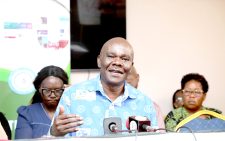Ex-president outlasted five American leaders in power

Emeka-Mayaka Gekara
Former US President Jimmy Carter who is Daniel arap Moi’s age mate —at least on record — left the White House in 1981 after serving one term.
By the time of Carter’s exit, Moi was serving his third year as president.
Moi’s political longevity can perhaps be illustrated by the fact that he outlasted five American presidents.
These include Carter who was President between 1977 and 1981, Ronald Reagan (1981-1989) George H Bush (1989-1993), Bill Clinton (1993-2001) and George W Bush who became President in 2001 as the Kenyan leader was preparing to retire the following year.
Reagan and George Bush (Sr) have since died. Reagan, the Hollywood actor who became one of America’s most popular presidents and hailed for the collapse of the Berlin Wall and strengthening of the US army, died in June 2004.
Moi, who will be buried tomorrow at his Kabarak home in Nakuru county, ruled Kenya for 24 years, having succeeded founding President Mzee Jomo Kenyatta in 1978.
In her book, Moi: The Making of an African ‘Big-Man’, Gabrielle Lynch attempts to explore the reasons for Moi’s long stay in power.
Lynch attributes Moi’s longevity to his Kalenjin roots, Christian faith, loyalty to Kenyatta whom he served as vice-president, discipline and a perception in the Kenyatta Cabinet that he was a moderate and a “passing cloud”.
“On joining the ruling party in 1964, he became a loyal ally of the then president Jomo Kenyatta.
This loyalty, together with his position as the pre-eminent Kalenjin politician, goes a long way to explain Kenyatta’s decision to appoint Moi as his vice-president in 1967,” writes Lynch.
“He wasn’t seen as a threatening figure and this helped him rise to the presidency on Kenyatta’s death,” she notes.
Though Moi made several trips to Washington, none of the US presidents visited Kenya while he was Head of State.
It took the pressure of President Bush senior and Clinton on Moi to open up Kenya’s political space.
This led to Moi’s decision to repeal controversial Section 2 A of the Constitution in 1991 to allow multi-party democracy.
During Moi’s rule, the US saw Kenya as an island of peace surrounded by conflict-ravaged countries such as Somalia and Sudan.
Because of this, the US and the United Nations often assigned Moi to broker peace in the region especially in Sudan, Mozambique and Somalia.
In his tribute, former Nigerian President Olesegun Obasanjo said Moi educated him on the Sudan crisis.
According to Obasanjo, under President Moi, Kenya was globally acknowledged as not only a frontline state that had widespread influence in cementing East African countries, but also one of the few African countries that have “served as a beacon for hope of African Renaissance”.












